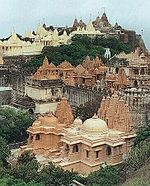
Shatrunjaya
Encyclopedia

The Palitana Temples of Jainism
Jainism
Jainism is an Indian religion that prescribes a path of non-violence towards all living beings. Its philosophy and practice emphasize the necessity of self-effort to move the soul towards divine consciousness and liberation. Any soul that has conquered its own inner enemies and achieved the state...
on Mount Satrunjaya, Palitana
Palitana
Palitana is a city in Bhavnagar district, Gujarat, India. It is located 50 km southwest of Bhavnagar city and is a major pilgrimage centre for Jains.-History:...
, Gujarat are considered the holiest of all pilgrimage places
Tirtha
In Jainism, a tīrtha |ford]], a shallow part of a body of water that may be easily crossed") is used to refer both to pilgrimage sites as well as to the four sections of the sangha...
by the Svetambara
Svetambara
The Śvētāmbara is one of the two main sects of Jainism, the other being the Digambar. Śvētāmbara "white-clad" is a term describing its ascetics' practice of wearing white clothes, which sets it apart from the Digambara "sky-clad" Jainas, whose ascetic practitioners go naked...
Jain community
Jain community
The Jains in India have been the last direct representatives of the Shramana tradition in India. They follow Jainism, as the dharma taught by the 24 Tirthankaras, the last of whom was Mahavira.-Cultural influence:...
. There are 863 temples
Derasar
A derasar is a temple for followers of Jainism, except for non-murtipujak Svetambaras. Derasar is a word used in Gujarat, Kutch and parts of Rajasthan, in other parts of India, the term Jain Mandir is used for all the Jain temples. Jain idols of Tirthankaras are worshipped there...
exquisitely carved in marble located on the hills. This temple-city has been built as an abode for the divine; hence, no one is allowed to stay overnight, including the priests. The main temple, on top of the hill, is dedicated to the first Tirthankara, Rishabha
Rishabha (Jain tirthankar)
In Jainism, R̥ṣabha or Ādinātha , also known as the "Lord of Kesariya") was the first of the 24 Tīrthaṅkaras. According to Jain beliefs, R̥ṣabha founded the Ikshvaku dynasty and was the first Tīrthaṅkara of the present age...
)
Myths
Some people call the following encounters myths some give facts and some believes them which lives in the heart of every follower of Jainism.- 1. The moolnayak murti-Lord Adinath's idol breathed 7 times, when it was first placed over there.
- 2. A layer of silver gets accumulated on idol every night and that serves as the priest's fees rather gift from god.
- 3. A small idol of Lord Suparshvanath Swami around 10" used to fly every night from one of near by temple to Lord Adinath`s Palm.
- 4. There is one and only one tree in the entire Temple Campus below which it is believed to hide the jewels, pearls, relics and other ornaments of time before humans.
- 5. The holy city is so pure and sacred that even if a pinch of soil is brought to home, it is considered very lucky
The town is considered by many Jains to be more important than the temple covered hills of Jharkhand, Mt Abu and Girnar. Palitana was the capital of a princely state of the Gohil Rajput clan. It is also one of the greatest tourist attractions in Gujarat for foreign tourists. Every year millions of people come to visit these temples.
There are hundreds of other temples (besides those on the Shatrunjaya
Shatrunjaya
The Palitana Temples of Jainism on Mount Satrunjaya, Palitana, Gujarat are considered the holiest of all pilgrimage places by the Svetambara Jain community. There are 863 temples exquisitely carved in marble located on the hills. This temple-city has been built as an abode for the divine; hence,...
hills). Guest houses (dharmashalas) are found in Palitana city. It is believed by Jains that every Jain should visit Palitana at least once in his lifetime to get "Bhavya" status (fit to attain nirvan or salvation).
Temple renovations
The antiquity of the temples is shown by their traditional history of renovation:- First Renovation : By Chakravarti Bharat, the son of Bhagawan Adinath.
- Second Renovation : By the King named Dandavirya.
- Third Renovation : By Shri Ishaneshvar in the interim period between the times of the first and the second Tirthankaras.
- Fourth Renovation : By Mahendra of the fourth upper world (dev-loko).
- Fifth Renovation : By Brahmendra of the fifth upper world.
- Sixth Renovation : By Chamarendra, Indra of Bhavanapatis.
- Seventh Renovation : By Sagar Chakravarti, the second Chakravarti of the times of Bhagawan Ajitnath.
- Eighth Renovation : By Vyantarendra in the times of Abhinandan Swami.
- Ninth Renovation : By King Chandrayasha in the times of Chandraprabh Swami
- Tenth Renovation : By Chakradhar, the son of Bhagawan Shantinath in the times of Bhagawan Shantinath.
- Eleventh Renovation : By Ramchandraji and Lakshamanji in the times of Munisuvrat Swami.
- Twelfth Renovation : By the five Pandavas in the times of Bhagawan Neminathji.
- Thirteenth Renovation : By Sheth Javed Shah of Mahuva in the year 108 of the Vikram era. He spent a million gold mohurs. In exuberance of joy, he died and was re-born in the fourth upper world (dev-loke).
- Fourteenth Renovation : By the advisor Bahud in the times of Kumarpal in the year 1213 of the Vikram era.
- Fifteenth Renovation : By Shri Samara Shah in the year 1371 of the Vikram era.
- Sixteenth Renovation : By Shri Karama Shah of Chitod on the auspicious sixth day of the dark half of the month of Vaishakh in the year 1587 of the Vikram era.
Further reading
- John E. Cort, Framing the Jina: Narratives of Icons and Idols in Jain History, Oxford U Press (2010). ISBN 0195385020

